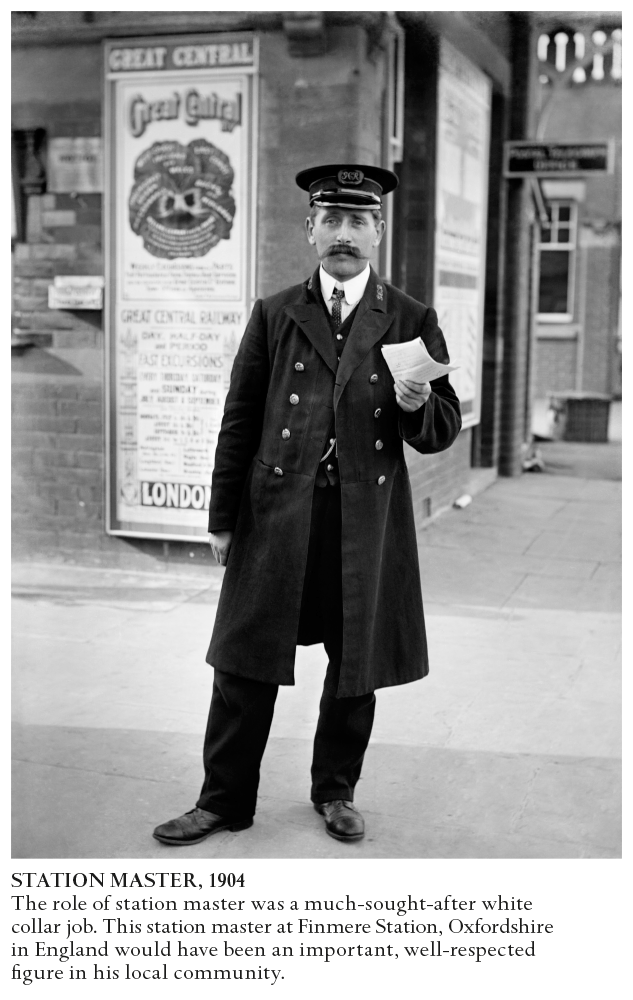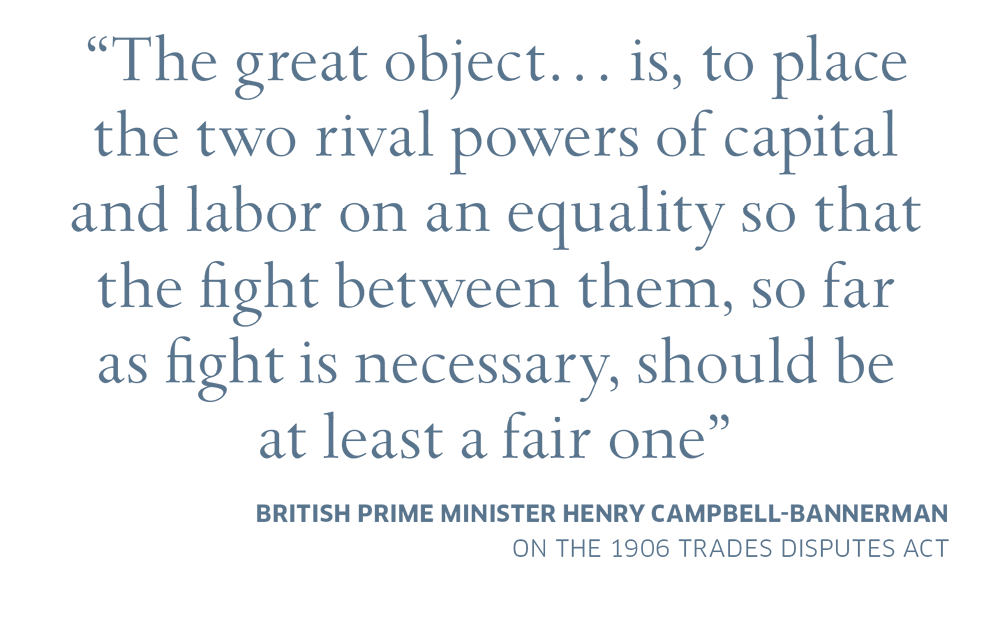The People Who Ran the Railroads
Railroads needed massive numbers of people to keep them running. Once the tracks were laid and the labor force of navvies had dispersed, a whole range of new personnel was required: engineers, firemen, porters, conductors, brakemen, maintainers, track workers, and tower operators. From their inception, many railroads were responsible for the largest workforce in their country. During the early days, and in many countries well into the 20th century, this workforce was almost exclusively male, and it was only during and after the World Wars that women began to be employed on the railroads in any number.
When the Liverpool and Manchester Railway opened in England in 1830 (see Liverpool and Manchester line), it was not only the first commercial passenger railroad line in the world, but it also introduced many standards and practices that other railroad companies all around the globe would follow. Strict discipline and attention to detail were vital in order for the trains to run on time and to ensure the safety of the new railroads, so employees were expected to follow military-style rules and wear smart uniforms. Since the armed services were the only contemporary organizations comparable in size and scale to the railroads, inevitably their ex-personnel became a major source of trained, well-disciplined labor. Indeed, many of the first workers who took up posts as porters, engineers, firemen, and track workers were former soldiers or sailors.

As the railroad business boomed in the mid-19th century, running the increasingly large companies required new skills and new types of professional workers, such as specialist engineers, accountants, lawyers, and managers. Many of these workers were also recruited from the armed services, but this time from the officer ranks. This did nothing to lessen the military character of the early railroads, and issuing “orders of the day”—setting out the daily tasks to be undertaken—became a popular practice at this time. However, the railroads were not solely the domain of military men; white-collar jobs such as ticket-office clerks were snapped up by anyone with a modicum of education, and the rapidly expanding industry was so different from any other that training mostly consisted of learning on the job.
In many countries, the structure of the railroads simply reflected the dominant social or political hierarchy. When India was under British colonial rule (pre-1947), the laborers and unskilled staff were native people, but managers were predominantly white Europeans, or Eurasians with an Indian mother and a European father. Recruiting people to work on the railroads was more difficult in parts of the world where the tracks traversed inhospitable and sparsely populated territory. On the Trans-Siberian Railway, completed in 1916 (see The Trans-Siberian Railway), some of the local workforce consisted of convicts who had been sent east to Siberia as punishment, but the railroad company could not afford to be too selective in its recruitment. Thus, many of the security guards hired to guard property at night had been banished to Siberia for robbery, passengers were often served by conductors and ticket clerks who had committed violent crimes, and large stretches of track were maintained by murderers and rapists.

The rules of the railroads were strict and workers would be fired instantly for serious offenses, such as falling asleep on the job, or have their wages docked for more minor transgressions, such as “deserting” their post to get a cup of tea. It was hardly surprising, however, that some people fell asleep at work: workers toiled for up to 16 hours a day, six days a week. Furthermore, some of the restrictions placed on railroad workers were notoriously harsh. Engineers on delayed trains received no extra pay, or time off in lieu, even if they worked several extra hours. Employees could be fired without any warning, but they were required to give employers three month’s notice if they wanted to leave. A London and South Western Railway Company employee who failed to give the required notice was prosecuted and sentenced to three weeks’ hard labor in a case that served as a warning to others.
Discipline was largely the domain of special police forces, employed by individual railroad companies. A railroad policeman’s duties included keeping order at stations, on the railroad, and in the local area around the railroad; removing trespassers and protecting railroad property. Most policemen carried a billy club and gun as weapons.

In most countries, working for the railroads was highly regarded, especially at the beginning of the railroad age. Even unskilled men could earn relatively high wages—railroad laborers earned twice as much as farm laborers. The relatively good pay, strict rules, and the stylish uniform gave the new industry prestige and afforded its workers a certain level of respect. Corporate loyalty was also strong as working for the railroads offered long-term stability, a permanent job in a world where that was a rarity, particularly in rural areas. Many men spent their whole working lives in the railroad industry and jobs were often kept within families for several generations. Railroad companies were usually keen to employ multiple members of the same family because they saw it as another way of fostering loyalty. The English railroad companies also devised other ways of keeping their employees happy: many jobs required working in remote areas so housing was provided at very reasonable rents. In towns, too, where workers had to start very early, housing was often provided near depots and stations. Providing cheap, convenient housing meant that workers would be reluctant to leave their jobs since it would make them, and their families, homeless. Moreover, the most efficient and most loyal workers were rewarded with the best homes. As Frank McKenna puts it in his history of railroad workers, “from the earliest days, the companies used housing policy as a means of staff control and for the preservation of company loyalty.” Free or concessionary fares for employees and their families were also a widespread benefit in kind that still exists today.
The railroad companies, therefore, took a paternalistic approach, controlling their employees with a firm but seemingly generous hand. However, railroad work was often very dangerous (only mining and fishing had a higher casualty rate), although most employers did not feel inclined to address the problem. The most hazardous jobs were switching and coupling or decoupling cars, as this involved working on the track right next to moving trains, but all track workers faced a high risk of being hit by a train. Moreover, in the early days of the railroads, individual cars didn’t have brakes, so when the engineer stopped the locomotive, the cars simply bumped into each other to stop. On average, more than five times as many workers were killed in railroad accidents as passengers. In Britain in the first half of the 1870s, for example, there was an average of 782 worker deaths per year. In the US, the number of fatalities was even greater, with more than 2,000 dying in 1888 alone, a toll which belatedly led to the sponsoring of the Railroad Safety Appliance Act in 1893, which gradually began to reduce the number of accidents.
Eventually, the loyalty of the railroads’ employees was simply pushed too far. Concerns over safety, wages that hadn’t kept pace with other industries, and autocratic management led railworkers to join together to form trade unions, which could coordinate campaigns for improvements to pay and conditions. The traditional loyalty that workers felt toward the railroad companies began to erode. In Britain, trade unions started to be organized in the 1860s. In 1867, workers on the North Eastern Railway went on strike over working hours—they wanted the company to agree to a maximum ten-hour-day or sixty-hour-week, which does not seem unreasonable by modern standards. However, the company reacted aggressively by employing strikebreakers and firing the strikers, so the strike collapsed.
However, trade unionism could not be held back for long and gradually organized labor movements gained a foothold over the ensuing couple of decades. Membership of unions grew quickly, and employers had to take notice. The unions were able to wrest a few concessions from the railroad companies, principally over the long hours and lack of overtime pay, but the companies were far from happy about it. In Britain, matters came to a head on the small Taff Valley Railway, a line serving several coal mines in South Wales. The Amalgamated Society of Railway Servants union had successfully negotiated a 60-hour-week in 1890, following a brief strike, but the Taff Vale Railway Company still failed to recognize the union officially. This provoked a second strike by the workers in 1900, but the company decided to sue the union. In 1901, the strike was judged to have been illegal and the union was ordered to pay £42,000 ($205,000) in compensation to the company, a judgment that made any further industrial action in Britain impossible. This incident provoked a bitter public reaction and as a result the Conservative government was heavily defeated in the 1906 general election. The new government, led by the Liberals, introduced the Trades Disputes Act, which effectively gave trade unions immunity from being sued in such circumstances. This resulted in a rapid growth of union strength.

Other countries followed a similar pattern. In the US, railroad workers began to organize into trade unions in the 1860s, but this was strongly opposed by the railroad companies. Railroad workers were involved in three major strikes in the last quarter of the 19th century and although all of them ended in defeats for the unions, union membership nevertheless increased and the rail companies were forced to recognize them. The US public largely supported the workers’ desire for basic rights and in the early years of the 20th century trade unions grew across the rail industry, and they remain relatively strong in the 21st century. Similarly, in the Netherlands, railroad companies were initially resistant to any legislation that would restrict the number of hours that employees worked. So, in the late 1890s, brotherhoods began to form and in 1901 they coalesced into a single trade union, the Federatie van Spoorwegorganisaties. The union’s first strike, in January 1903, was in support of dockworkers and immediately won concessions, but a second strike in April over working conditions resulted in mass firings. Eventually, though, hours were reduced and workers’ wages increased.

Today, railroads require far less labor. Interlocking towers have been replaced by rail traffic control centers covering vast regions; electric and diesel trains only require a single engineer; stations rarely employ porters; ticket sales are often automated; and machines have replaced people for some track safety and maintenance tasks. Some modern subway systems are even operated without engineers, with trains controlled by computers. The days when the railroads were the largest and most prestigious employers are largely over, although Indian Railways is still the ninth largest employer in the world. However, with more than 620,000 miles (1,000,000km) of railroads around the world, a significant, skilled workforce remains vital to build, maintain, and operate the railroads.